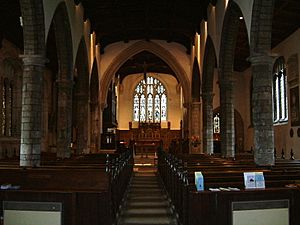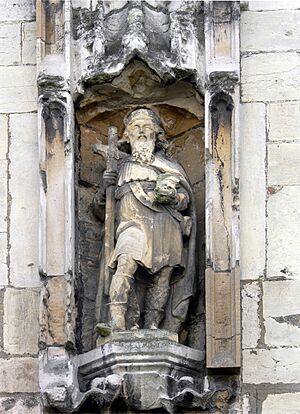St Olave's Church, York facts for kids
Quick facts for kids St Olave's Church, York |
|
|---|---|

The interior of St Olave's church, facing east
|
|
| 53°57′44.3″N 1°5′20.6″W / 53.962306°N 1.089056°W | |
| OS grid reference | SE 5986 5219 |
| Location | York |
| Country | England |
| Denomination | Church of England |
| Churchmanship | Liberal Anglo-Catholic |
| Website | www.stolaveschurch.org.uk |
| History | |
| Dedication | St Olaf |
| Consecrated | c. 1050 |
| Architecture | |
| Heritage designation | Grade I listed |
| Administration | |
| Parish | St Olave with St Giles, York |
| Deanery | York |
| Archdeaconry | York |
| Diocese | Diocese of York |
| Province | Province of York |

St Olave's Church, York (pronounced Olive) is a very old and important church in York. It is a Grade I listed building, which means it is protected because of its special history and architecture. This church is part of the Church of England. You can find it on Marygate, right next to the ruins of St Mary's Abbey.
Contents
History of St Olave's Church
St Olave's Church is located inside the old walls of St Mary's Abbey. The abbey itself was ruined a long time ago during the Dissolution of the Monasteries. The church is named after St Olaf, who is the patron saint of Norway.
Early Beginnings and Earl Siward
Records from the Anglo-Saxon Chronicle in 1055 mention that ‘This year died Earl Siward at York; and his body lies in the minster at Galmanho, which he had himself ordered to be built and consecrated, in the name of God and St. Olave, to the honour of God and to all his saints.’
Galmanho was the old name for the area where the church stands today. It is believed that Earl Siward had his home in York nearby. This mention in 1055 is the earliest known time a church was dedicated to St Olaf anywhere in the world!
Building and Repairs Over Time
St Olave's Church was largely rebuilt in the 1400s. Many repairs were done in the 1720s. This included adding windows to the north side. This wall had once been part of the abbey and later helped defend the city.
The church was fixed up again between 1848 and 1849. It reopened on Wednesday, February 14, 1849. More renovations started in 1887. The church closed for five weeks and reopened on September 2, 1888. During this time, an old plaster ceiling was removed. The pillars, arches, and walls were cleaned of old paint and plaster.
A new chancel (the part of the church near the altar) was added between 1887 and 1889 by George Fowler Jones, an architect from York. It was made even bigger in 1906. This part of the church has a beautiful 15th-century window with five sections. Even with all these changes, the church still mostly looks like it did in the 1400s.
Church Life Today
St Olave's is known for its strong musical traditions. It has a large choir and a organ that was recently fixed up. The church also has six bells that are used for change ringing, which is a special way of ringing bells in a pattern.
The orchestra of the Academy of St Olave's performs three concerts each year. They also play music for one special church service on Remembrance Sunday. The main Sunday service, called the sung eucharist, happens at 10:30 AM.
Church Leaders
The leaders of St Olave's Church have been called different things over the years. They were first known as Chaplains. From 1499, they were called Curates, and from 1663, they became Vicars.
Important Memorials
Inside the church, there are memorials to several people. These include:
- George Hutchinson (who passed away in 1775)
- Michael Loftus (who passed away in 1762)
- William Etty (a famous painter who passed away in 1849)
Burials at St Olave's
One very important person buried at St Olave's Church is:
The Organ
The pipe organ at St Olave's was built by J. W. Walker & Sons Ltd in 1907. You can find detailed information about this organ on the National Pipe Organ Register.


